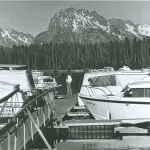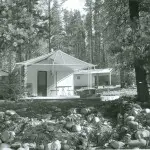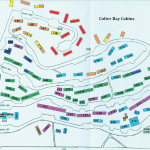colter bay
When the Civilian Conservation Corps (CCC) arrived in Jackson Hole in 1933-1935, they set up several camps around the valley: at the base of Jenny Lake, and Leigh Lake, near Lizard Creek and a small isolated bay on Jackson Lake. The main camp was located at Jenny Lake, with a few buildings remaining today in the form of the Exum Mountain Guides. The CCC had several projects throughout the valley, constructing campgrounds, park headquarters, trails and other visitor comforts.
On Jackson Lake, they were tasked with the removal of the dead trees that had amassed along the shoreline when the Lake was dammed in 1906. The dam caused the lake level to increase, flooding out the trees lining the shore. These trees then died, and resulted in what locals described as an “unsightly mess.” From 1933 and 1937, over 7,000 trees would be removed from around the lake.
While Jackson Lake’s shorelines would not be officially part of Grand Teton National Park until 1950, in these early years the lake was still a top tourist destination in the valley. It was only surpassed by Jenny Lake, due to the concessions and campground already in place there.
With the start of World War II, the CCC departed the valley in 1941. The former location of the CCC camp on Jackson Lake would remain unused for only two years. Due to the CCC’s presence, the land had been cleared for their use and the small bay it was located on was seen as an ideal place to access the lake itself.
In 1943, the area was declared part of the Jackson Hole National Monument by President Roosevelt. John D. Rockefeller, Jr. had been a presence in the valley since the late 1920s, buying up over 35,000 acres with the intention to donate it for a National Park. He was aware of the small bay on Jackson Lake where the CCC had been, and began eyeing the location as the ideal site for a new campground.
The only other formal campground in the valley was at Jenny Lake, and it was always at capacity. In drawing visitors up to the northern end of the valley, nearer to his lodgings at Moran, Rockefeller saw an opportunity.
Due to Rockefeller’s large land purchases, he also had a small army of old homesteading cabins that needed to be removed in order to return the homesteads back to their natural appearance. Rather than incur the expense of demolition and removal, Rockefeller and his partners in the National Park Service moved over 186 small cabins to the newly-named Colter Bay from around the valley. The majority of the cabins come from: the old town of Moran (Ben Sheffield’s Teton Lodge Company), the Square G Ranch, the Half Moon Girl’s Dude Ranch, the Circle H Ranch and the old Jackson Lake Lodge.
Upon its opening in 1957, the Colter Bay Village could host up to 3,000 guests in the renovated cabins, tent sites and an RV park. The distinctive corner notches and varying craftsman skill resulted in different construction techniques and designs that demonstrates which cabins came from which ranch. All of the cabins received new foundations and new roofs, along with plumbing and electricity.
When Colter Bay opened in 1957, plans were already in motion to enlarge the area and bring in permanent visitor comforts. The cabin village was just the beginning of a larger master plan. In 1966, the National Park Service would be celebrating a milestone; 50 years of service to the American public. There was a national movement to update and part of the plan was to renovate all of the visitor services infrastructure in every national park to celebrate the anniversary. Known as Mission 66, this plan would overhaul Colter Bay, the result is its appearance today.
Between 1956 when the plans were initiated and 1966, additional campground loops, maintenance and utility areas, general store improvements, the marina, amphitheater, employee housing, cafeteria, laundromat, and associated roads were all constructed. The Indian Arts Museum would later open in 1973 (having been planned after the anniversary celebration in 1969).
The significance of Colter Bay’s participation in the Mission 66 program also sets it aside from the projects at other National Parks. Colter Bay’s initiation construction and opening was seen as an experiment for a national-scale program. It was unusual in its private backing (the Rockefellers) but the success was significant enough for the National Park Service to embark on the official Mission 66 program nation-wide. The historic cabin village and the RV sites would be a first for a National Park campground.
Today, Colter Bay remains one of the most popular campgrounds in Grand Teton National Park. While it has undergone many changes and expansions in the employee housing and maintenance areas, the cabin village remains a hidden gem. Few realize the legacy of homesteading, dude ranching, and tourism these small cabins carry. Their distinctive features and construction remain as evidence of the history of the valley, and continue to serve a similar purpose for which they were built. Colter Bay’s hidden history is also its most significant, but for those who know where to look it is not forgotten.
Text by Samantha Ford, Turn Stone Research


